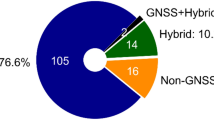Abstract
A new algorithm for global navigation satellite system attitude determination onboard a spacecraft was developed. A distinct feature of the algorithm is the extrapolation of the measurements to a common epoch within a Kalman filter. The necessity for the extrapolation arises from the usage of non-synchronized low-cost receivers. The extrapolation terms typically range from \(- 6\) to +\(6\) m for u-blox receivers. Thus, no solution can be obtained without a proper extrapolation. A validation was carried out with synthetic data as well as with signal simulator data. The algorithm delivers an attitude estimation with an accuracy below 1° for three orthogonal baselines of 10 cm length. In conclusion, the algorithm is proven to work, offering a very efficient method of attitude determination onboard a spacecraft.











Similar content being viewed by others
References
Aghili F, Salerno A (2013) Driftless 3-D attitude determination and positioning of mobile robots by integration of IMU with two RTK GPSs. IEEE/ASME Trans Mechatron 18(1):21–31
Arbinger C, Enderle W (2000) Spacecraft attitude determination using a combination of GPS attitude sensor and star sensor measurements. In: Proceedings of the ION GPS 2000. Institute of Navigation, Salt Lake City, September 19–22, pp 2634–2642
Birmingham WP, Miller BL, Stein WL (1983) Experimental results of using the GPS for Landsat 4 onboard navigation. Navigation 30(3):244–251
Cannon ME, Sun H (1996) Experimental assessment of a non-dedicated GPS receiver system for airborne attitude determination. ISPRS J Photogramm Remote Sens 51(2):99–108
Chen W, Qin H (2012) New method for single epoch, single frequency land vehicle attitude determination using low-end GPS receiver. GPS Solut 16(3):329–338
Cohen CE (1992) Attitude determination using GPS. Dissertation, Department of Aeronautics and Astronautics, Stanford University
Cohen CE, Lightsey EG, Parkinson BW, Feess WA (1994) Space flight tests of attitude determination using GPS. Int J Satell Commun 12:427–433
Crassidis JL, Markley FL (1997) New algorithm for attitude determination using global positioning system signals. J Guid Control Dyn 20:891–896
CubeSat Design Specification (2015) Revision 13—updated 4-6-2015. http://www.cubesat.org/resources/
Dach R, Lutz S, Walser P, Fridez P (eds) (2015) Bernese GNSS Software Version 5.2. Software user manual. Astronomical Institute, University of Bern, Bern
Diebel J (2006) Representing attitude: Euler angles, unit quaternions, and rotation vectors. Technical report, Stanford University. https://www.astro.rug.nl/software/kapteyn/_downloads/attitude.pdf
Farrell JL, Stuelpnagel JC, Wessner RH, Velman JR, Brook JE (1966) A least squares estimate of satellite attitude (Grace Wahba). Siam Rev 8:384–386
Gebre-Egziabher D, Hisamoto CS, Sheikh SI (2016) Small satellite attitude determination. In: Fourati H, Belkhiat DEC, Iniewski K (eds) Multisensor attitude estimation: fundamental concepts and applications. CRC Press, Boca Raton, pp 427–444
Giorgi G, Teunissen PJG, Gourlay TP (2012) Instantaneous global navigation satellite system (GNSS)-based attitude determination for maritime applications. IEEE J Ocean Eng 37(3):348–362
Graas F, Braasch M (1991) GPS interferometric attitude and heading determination: initial flight test results. Navigation 38(4):297–316
Hilla S (2010) The extended standard product 3 orbit format (SP3-c). ftp://igs.org/pub/data/format/sp3c.txt
Hollenstein CH, Männel B, Serantoni E, Scherer L, Rothacher M, Kehl P, Ivanov A (2014) Concepts and testing of low-cost GNSS receivers for CubeSat orbit and attitude determination. In: Proceedings of NAVITEC. Noordwijk, Netherlands
Ivanov AB et al (2015) CubETH: nano-satellite mission for orbit and attitude determination using low-cost GNSS receivers. IAC-15, B4.4.5. In: 66th International astronautical congress. Jerusalem, Israel
Montenbruck O, Markgraf M, Garcia-Fernandez M, Helm A (2008) GPS for microsatellites—status and perspectives. In: Sandau R, Röser HP, Valenzuela A (eds) Small satellites for earth observation. Springer, Berlin, pp 165–174
Remondi BW (2004) Computing satellite velocity using the broadcast ephemeris. GPS Solut 8(3):181–183. doi:10.1007/s10291-004-0094-6
Rothacher M, Schaer S, Mervart L, Beutler G (1995) Determination of antenna phase center variations using GPS data. In: Gendt G, Dick G (eds) Special topics and new directions, 1995 IGS workshop. Potsdam, pp 205–220
Sabatini R, Rodriguez L, Kaharkar A, Bartel C, Shaid T (2012) Carrier-phase GNSS attitude determination and control system for unmanned aerial vehicle applications. ARPN J Syst Softw 2(11):297–322
Simgen Software User Manual (2012) Spirent Communication plc, Devon
Teunissen PJG (1995) The least-squares ambiguity decorrelation adjustment: a method for fast GPS integer ambiguity estimation. J Geod 70(1):65–82
Teunissen PJG (2007) The LAMBDA method for the GNSS compass. Art Satell 41:89–103
Teunissen PJG (2009) Integer least squares theory for the GNSS compass. J Geod 84(7):433–447. doi:10.1007/s00190-010-0380-8
Teunissen PJG, Giorgi G, Buist PJ (2011) Testing of a new single-frequency GNSS carrier phase attitude determination method: land, ship and aircraft experiments. GPS Solut 15(1):15–28. doi:10.1007/s10291-010-0164-x
u-blox M8 Product Summary (2016) R04. u-blox, Thalwil, Switzerland. https://www.u-blox.com/en/product/neo-m8-series
u-blox M8 Receiver Description (2016) v15.00-19.00, 22.00, R11. u-blox, Thalwil, Switzerland
Um J, Lightsey EG (2001) GPS attitude determination for the SOAR experiment. Navigation 48(3):181–194
Ward LM, Axelrad P (1997) A combined filter for GPS-based attitude and baseline estimation. Navigation 44(2):195–214
Welch G, Bishop G (2006) An introduction to the Kalman filter. University of North Carolina. https://www.cs.unc.edu/~welch/media/pdf/kalman_intro.pdf
YUMA almanac (2016) United States Coast Guard, GPS NANUs, Almanac & OPS Advisories. http://www.navcen.uscg.gov/?pageName=gpsAlmanacs
Acknowledgements
We would like to thank Dr. Oliver Montenbruck and Markus Markgraf at DLR for providing access to the GNSS Signal Simulator and for the great support during the data acquisition. This work was supported by ETH Research Grant ETH-43 14-2.
Author information
Authors and Affiliations
Corresponding author
Rights and permissions
About this article
Cite this article
Willi, D., Rothacher, M. GNSS attitude determination with non-synchronized receivers and short baselines onboard a spacecraft. GPS Solut 21, 1605–1617 (2017). https://doi.org/10.1007/s10291-017-0639-0
Received:
Accepted:
Published:
Issue Date:
DOI: https://doi.org/10.1007/s10291-017-0639-0




